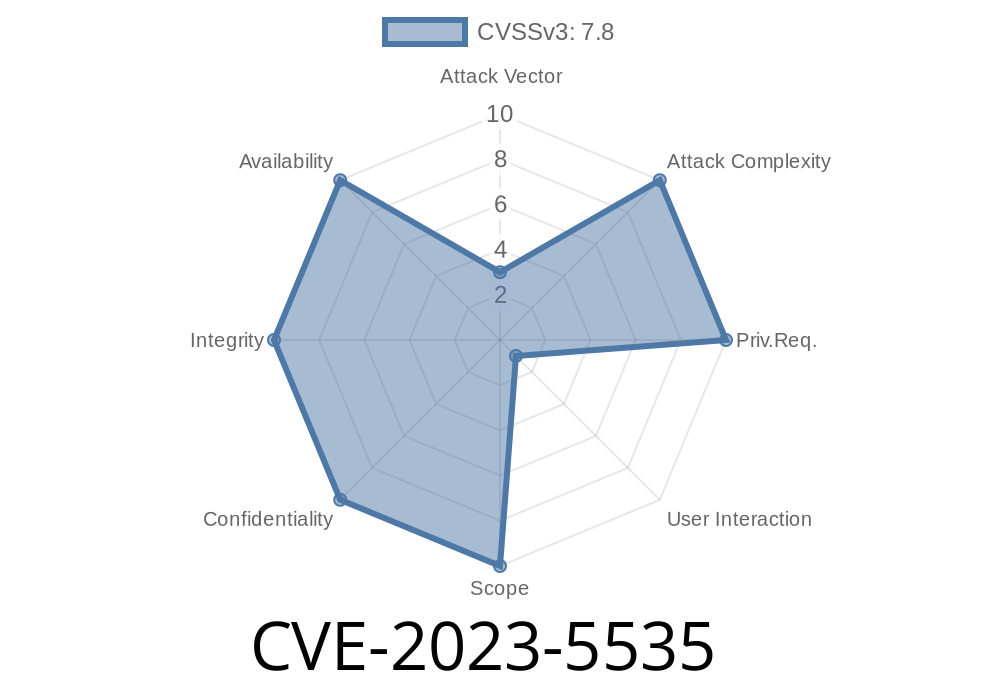---
Vim is one of the most popular text editors on the planet. A tool trusted daily by developers, sysadmins, and power users. But even respected software can have dangerous bugs, including those that can let an attacker take control of your computer. In late 2023, security researchers uncovered one such vulnerability in Vim—a use-after-free bug (CVE-2023-5535)—that could have allowed malicious code execution on vulnerable systems.
This post is a detailed, plain-English exploration of this vulnerability, including references, a code walkthrough, and an explanation of how it might be exploited.
What Is CVE-2023-5535?
CVE-2023-5535 is a *use-after-free* vulnerability in vim/vim (the official Vim repository), affecting versions prior to v9..201.
In Simple Terms
A "use-after-free" means the program tries to use memory after it's already freed (returned to the system). This can allow attackers to manipulate the freed memory, potentially executing their own code, or causing a crash.
Here are authoritative links for further reading
- NVD Entry: https://nvd.nist.gov/vuln/detail/CVE-2023-5535
- Vim Patch Note: patch-9..201
- Vuln Disclosure: huntr.dev report
Where Is It?
The bug is in the code that handles autocmd events in Vim, specifically when handling buffer-related operations.
To quote the patch commit:
> Problem: After a buffer is closed in an autocmd callback, accessing bufref may result in use-after-free.
This means, under certain conditions, Vim deallocates (frees) a buffer while still keeping a pointer to it—and later tries to access it.
Minimal Trigger Example
Suppose you have an *autocmd* (auto-command) in your Vim configuration that deletes a buffer every time you open a new one:
augroup UAFDemo
autocmd!
autocmd BufEnter * bwipeout!
augroup END
Now, if you open another buffer, Vim may use a reference to the now-deleted buffer, leading to a use-after-free.
A Look At the Fix
In the Vim patch, the developers replaced code like this (simplified):
if (bufref_valid(&bufref))
{
do_something_with_buffer(bufref.br_buf);
}
with a safer pattern
if (bufref_valid(&bufref))
{
// refresh the pointer before use
buf_T *buf = bufref.br_buf;
do_something_with_buffer(buf);
}
*bufref_valid()* checks if the buffer still exists. But if an autocmd has deleted the buffer and the code still tries to use the buffer pointer, bad things happen.
Real-World Danger
An attacker could craft a malicious Vim session (e.g., with a custom .vimrc or a rogue file that triggers autocmds) to cause the use-after-free. If they can manipulate what gets allocated after the buffer is freed, they could potentially:
For Example
If Vim processes an untrusted file with dangerous autocmds embedded, and these autocmds manipulate buffer lifecycles during editing, this could open a pathway for exploitation.
Proof-of-Concept (PoC) Code
While there's no public weaponized exploit published, a crash trigger can look like this (in your .vimrc):
function! UAFExploit()
" Opens and deletes a buffer inside an autocmd, risking a dangling pointer.
execute "tabnew"
execute "bwipeout!"
endfunction
autocmd BufWinEnter * call UAFExploit()
When you open a file in Vim, this code can cause use-after-free conditions and potentially crash Vim.
Update Vim! Make sure you're running v9..201 or later.
- On Ubuntu/Debian: sudo apt update && sudo apt install vim
- Or build from source: Vim Releases
Conclusion
CVE-2023-5535 is a classic example of how powerful scripting in text editors can introduce very real security risks. Most users aren't targeted, but it's a reminder that even beloved tools like Vim need regular patching.
Always update. Always be careful with plugins, config files, and unknown files.
Stay safe and keep coding!
References/Sources
- CVE-2023-5535 at NVD
- Vim Patch fixing the bug
- Huntr report
*Stay tuned for more vulnerability breakdowns in simple language!*
Timeline
Published on: 10/11/2023 20:15:00 UTC
Last modified on: 11/03/2023 22:15:00 UTC
